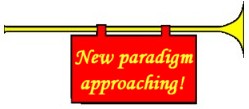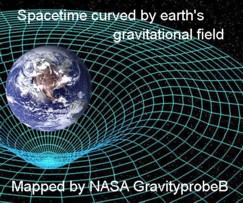“And don’t speak too soon,
for the wheel’s still in spin
…..
for the times they are a-changin’.”
Bob Dylan.
—————————————————————————————————–
Catching Up
It’s been a while since the last article was posted on this blog, but that interval hasn’t been without its significant events – and we’re not just talking about the Olympics (or the UK royal birth).
Over that period, in mainstream ISI-ranked international journals, there have been peer-reviewed papers heralding at least three paradigm shifts in major aspects of accepted scientific thinking: particle physics; relativity; and biological science.
So, if fundamental scientific principles are being turned on their heads, why aren’t the newspapers, or at least the popular science magazines, full of it?
| Well of course science – all of science – is a naturally conservative discipline. And a herald is there to announce what is on its way – an early warning system, so to speak. |
Widespread recognition of a new scientific paradigm, let alone acceptance, doesn’t come overnight.
But the evidence is there for all to see. Let’s have a look at some of it. (We can also check out a radically new learning facility that’s recently come on-line to offer study courses on some of the new scientifically-validated ideas that are surfacing.)
—————————————————————————————————–
Good Vibrations? Smell Will Tell.
Why, do you think, might one of the world’s leading scientific research foundations declare earlier this year that “Quantum Mechanics Stinks”?
No, it’s not because Planck, Schrödinger and all those who’ve followed in their footsteps over the past century have been proved wrong. Far from it. In fact, QM has been used to show up a long-standing fallacy in another branch of science – and it’s one that could revolutionize an essential aspect of daily life.
Put simply, over the past few years a number of scientists have become increasingly dubious about the standard ‘lock and key’ model of cell receptor sites. This says that the active points on the outside of a living cell recognise complex molecules by their shape, like a key fitting into a keyhole. But this view has become less and less plausible over the years.
No flies on us!
| Now some clever experiments with drosophila and specially-constructed organic molecules have shown that two identically shaped molecules with different vibrational patterns smell different to those humble flies (yes, can you believe it, fruit flies just 3mm in length can be trained to respond selectively to particular smells). |
| Experiments on human subjects have shown the same, also molecules with very similar vibrations but different shapes have been shown to cause a very similar response at the cell receptors of the olfactory organs – the sense of smell. |
This has led to a radically new Swipe Card Model of cell receptors, named after the way that electronic sensors recognize a swipe card by its electromagnetic vibrational pattern.
All change!
Functioning of cell receptors is fundamental to the functioning of any living organism, including you and me. If that functioning is based on a quite different property than we formerly thought, this could have far-reaching consequences for our understanding and treatment of a whole host of medical conditions.
This sea-change in our understanding of such a key (!) aspect of cell biology is unquestionably a major paradigm shift with very significant implications.
—————————————————————————————————–
So what IS stuff made of?
| Ever since the time of Democritus (and earlier) people have puzzled over what stuff – any stuff – is made of.
Democritus used the word atomos (‘uncuttable’) to describe the smallest bits of stuff, and that word has stuck long after we knew that atoms are definitely not uncuttable. But if we keep on cutting – down to electrons, protons and neutrons, then down further to quarks – where does it all end? |
The answer comes from a rather unlikely direction: the nature of time itself. Time has always been thought of as a flow, a process, often likened to the flow of a river. Einstein proposed that everything moves through time, as a sort of fourth dimension.
Relativity? Absolutely!
Now, it turns out, all of Einstein’s findings in Relativity can be explained by turning that idea on its head: time moves through everything. More precisely, the effects of time are carried through everything by some sort of energetic flow. The limiting (and invariant) speed of light; relativistic time dilation (slowing down of time); increase of apparent mass with speed – all drop out very neatly just by considering that energetic flow of ‘time’.
That flow turns out to be electromagnetic (EM) energy – what we normally refer to as ‘light’. If we think of every elementary particle of matter as a photon (or combination of photons) of EM energy looped round into a tiny closed circuit, then the maths work out perfectly. That includes the maths relating to time – if we simply recognize that the effects of time must be carried around particles by those formative energy flows, and between particles and objects by the energies passing from one to another.
Back to the future (relatively speaking).
This isn’t news. For thousands of years mystics have been telling us that ‘everything is made of light’. The visionary particle physicist David Bohm believed that matter is made from ‘crystallized’ or ‘condensed’ light. Schrödinger, whose wave equation is central to Quantum Mechanics, deduced the concept of zitterbewegung, a cyclic motion in particles at the speed of light (a concept supported by recent experimental findings).
What is news, though, is that following this concept through mathematically leads directly to all of the scientifically verified findings of Special Relativity as originally intuited by Einstein. Knowing why the speed of light is absolute, why time slows down with increasing speed of motion, why E=mc2, opens the way for other possible findings on the fundamental nature of space, time and matter.
For example, the phenomenon of quantum entanglement – what Einstein called ‘spooky action at a distance’ – might ultimately be explained by further exploration in this direction.
The paper Sub-Atomic Particles: The Earliest Adaptive Systems presents this radically new paradigm of particle structure in the peer-reviewed international journal Kybernetes. Having arisen through a systems approach to the interrelationship between matter, energy and time, it’s appropriate that this new perspective should appear in a systems-sciences journal.
—————————————————————————————————–
When the Frame’s Not the Same (relatively speaking)
Einstein’s Theory of Relativity has been pretty well established for a century now. With one or two exceptions, such as Black Holes and the original Big Bang itself, it’s proved very effective at explaining a wide range of physical phenomena.
But there are still nagging questions that bother quite a few scientists. Apart from the fact that Black Holes shouldn’t exist – but they do – there’s the issue of the Cosmic Microwave Background Radiation. How does that fit in, exactly?
A blast from the past.
| The CMBR is like a sort of cosmic 3-D wallpaper, a backdrop to everything else that’s going on in the cosmos. It has its own state of motion – the ‘rest-frame of the CMBR’, as it’s called. A spacecraft that’s comoving (i.e. stationary) with respect to that rest-frame is travelling such that the CMBR has the same average frequency all around it. |
But Relativity tells us that every inertial state of motion (constant velocity, no gravitational effects) is equivalent; no one state of motion is in any way special. So how can there be just one state of motion that happens to coincide with the ambient state of the relic radiation left over from the formation of the universe? Doesn’t the fact of one special state of motion, defined by the electromagnetic debris left by the emerging cosmos, rather give the game away that all states of motion are not created equal?
Of course it does. But Einstein said that motion has to be 100% relative for all his other results to stand up.
It ain’t necessarily so …
Happily that’s not the case. If we go back to that paper on light-based particle formation we find that all those relativity results drop out without all reference frames (states of motion) having to be equivalent. It just seems that way to all those spacecraft et al that are moving (maybe pretty swiftly) with respect to that unique universal rest frame.
This brings us to yet another paradigm shift. This one – the (non-)absolute nature of motion – could turn out to be the most significant, long-term. Because this one paints a radically different picture of the nature of space and time from the one we’re used to.
Reach for the stars!
Our understanding up to now has pretty well ruled out any possibility of travelling beyond our own planetary system – other than in space-arks that could take generations to get anywhere, with no way back if it doesn’t work out. With this new perspective all the scare stories about faster-than-light travel turning cause-&-effect upside down don’t apply. Light-speed still presents some sort of limit, but ways around that limit suddenly seem a lot more plausible.
| That’s not all. This new paradigm of space and time supports Einstein’s idea of gravity causing ‘curved spacetime’, at the same time explaining (in a second published paper) how and why that works in practical terms. If we’re going to get round that light-speed limit, a proper understanding of the mechanisms of curved space- time has got to come pretty high on the agenda. |
Three in a row.
So there we have it: three new paradigms – in biology, particle physics and relativity. We never do things by halves in this blog!
If you’re interested in learning more, the website www.transfinitemind.com has plenty more good stuff, including free downloads of presentations, articles and the like.







Superb! All very enlightening!
As ever, neat punning, neat premises !